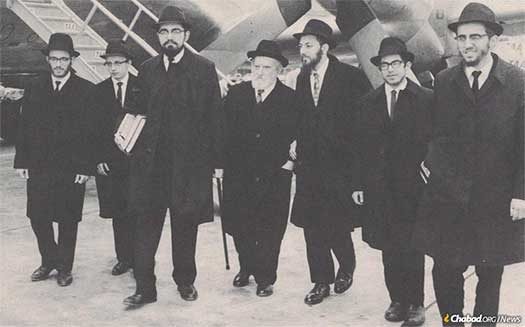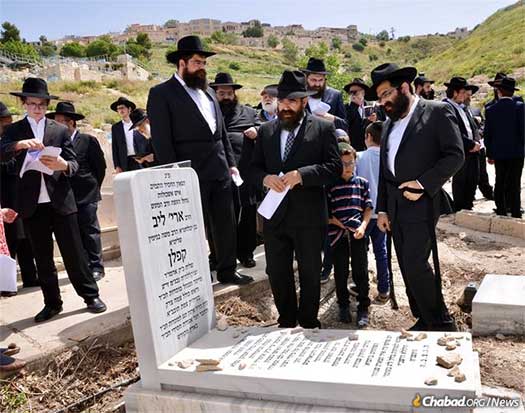
The Rabbi Who Pioneered the Jewish Revival of Safed
In Chabad circles, there are no small assignments for the movement’s emissaries, sent near and far to bolster and spread Judaism, often in isolated outposts. But there are some who take on missions of heroic proportion, such as one assigned a young Crown Heights couple in the summer of 1973.
Married only two years and, unbeknownst to them, with the Yom Kippur War looming, Rabbi Aryeh Leib Kaplan, 25 at the time, and his wife, Sarah, along with their infant son, Menachem Mendel, were dispatched by the Rebbe, Rabbi Menachem M. Schneerson, of righteous memory, to Safed. Their charge was to restore the historic city in northern Israelto its former glory, fortify Judaism in the region, and provide the area protection through spiritual means from enduring threats from the north.
The Kaplans’ arrival marked a turning point in Safed’s Jewish rebirth. Though in the two decades prior to Kaplan’s arrival it began to see some immigration of Chassidic and other Jews, and the establishment of an artists’ colony, Safed for centuries had been a majority Arab city, and at the time of State of Israel’s War of Independence in 1948 had a population of 12,000 Arabs and only 1,700 Jews living in the city’s Jewish quarter. This was in contrast to what is known as the Golden Age of Safed some four centuries before when Kabbalistic greats such as Rabbi Moses Cordovero, Rabbi Isaac Luria, known as the Ari, and Rabbi Joseph Caro, author of the renowned Shulchan Aruch (Code of Jewish law) and their students graced the city.
Hand-picked for his multiple talents as a Torah scholar, promising leader and tireless organizer, Kaplan immediately set the Rebbe’s mission into motion.
Landing in Safed in early August on the third day of the Hebrew month of Av, Kaplan set out to accomplish his first directive: to resurrect the city’s original Chabad synagogue, later to be called the Tzemach Tzedek, which had fallen into total disrepair, in time for the penitential prayers (selichot) preceding Rosh Hashanah, less than two months away. The synagogue and learning center, erected in the 1800s at the behest of and with funding from the third Lubavitcher Rebbe, Rabbi Menachem Mendel, known as the Tzemach Tzedek, indeed re-opened its doors that year for the High Holidays with enough participants to hold services.
The month before, at the beginning of the Hebrew month of Elul, another priority of the Rebbe was achieved: the establishment of a kolel(learning program for adult men), temporarily set up at a nearby location, with ten initial participants.
Before Kaplan’s tragic passing at age 50, some 25 years into his assignment, he went on to oversee the establishment of 25 kindergartens; elementary schools for boys and girls; two yeshivahs, and two women’s seminaries, drawing both local and large international student bodies; a three-section residential apartment complex with an adjoining large synagogue; and a third yeshivah for the sons of Chabad-Lubavitch emissaries around the world. He also helped facilitate the development of the world-renowned Ascent Institute of Safed outreach center.
His work in Israel extended beyond Safed. He served as chairman of the Lubavitchumbrella organization in Israel for many years, which brought him into contact with leading religious and political leaders, many of whom privately sought his advice and perspective on public policy matters.
Kaplan combined his intense and successful activism with rare scholarly pursuit. As a young yeshivah student in New York, Kaplan quickly became one of the oral scribes who would memorize and transcribe the Rebbe’s lengthy analytical talks on Shabbat and Holidays (which could last for more than six hours). In addition to his brilliant memory, he was known for his deep grasp of Talmudic explication and Chassidic philosophy. Later in life he authored three books, a quarterly journal, and numerous thoughtful essays on a wide range of Judaic study topics. Heeding the Rebbe’s instructions, Kaplan also held the position of dean and senior Talmudic lecturer in the post-graduate rabbinical seminary.
Untimely Passing in 1998
Kaplan perished in a traffic accident while traveling to an inauguration of a Chabad centerin Russia in 1998. He is being remembered this week by family and friends and the entire community on his 20th yahrzeit (anniversary of the passing) on Tuesday, the 16th day of the Hebrew month Iyar.
At a Shabbat tribute at one of Kaplan’s key institutions, Synagogue Levi Yitzchok, his son, Rabbi Chaim Kaplan, to whom the mantle of leadership was passed at the tender age of 23, told the community that his father, dubbed by the Rebbe as one of his “generals,” was the epitome of the fully devoted emissary.
Chaim Kaplan quoted the interpretation of Rashi, the famous commentator, that the seemingly redundant use of two forms of the verb to say in the first verse of the weekly Torah portion Emor teaches that the Jewish priestly caste must learn from Moses the laws that apply to them and also teach them to their children.
Kaplan said emissaries like his father are akin to fully involved Jewish priests, who were required to completely immerse themselves in their tasks, including teaching the laws to their children.
“A Chabad emissary is not merely assigned a specific mission, but rather, he transforms his whole existence into being an emissary,” Kaplan told the crowded synagogue. “Unlike agents of organizations who have private lives with certain projects to accomplish, the Rebbe expected that for his emissaries, their entire life would become their mission — whether that entails big community and major building projects or picking up a piece of trash on a community walkway.”
Influenced by the Rebbe
Influenced by the Rebbe from an early age, Rabbi Aryeh Leib Kaplan had his first personal meeting with him at 14. Before sending Kaplan to Safed, the Rebbe dispatched him at age 20 to lead a group of rabbinical students to help establish the first yeshivah in Australia, rewarding them with an invitation to his private Passover Seder upon their return.
Another of Kaplan’s sons, Rabbi Zalman Kaplan, also spoke of his father’s exceeding devotion to the community at a Shabbat tribute at another synagogue in Safed, which has become a city continuously sprawling with Chabad and other Jewish activity.
“He was very focused on his shlichus to the point of putting everything else aside, even his own learning and praying, even though he was a brilliant Torah scholar,” said Zalman, 17 at the time of his father’s passing and now Rosh Yeshivah (head of yeshivah) of Safed’s Yeshivas Tzeirei Hashluchim for children of Chabad emissaries worldwide and others. “Instead of learning in the hours before praying on Shabbos morning , my father used to participate in an earlier service to be sure they had what they needed, and would then also participate in the later minyan.
“He would then spend hours on the evening of Rosh Hashanah praying, and at other times find time to make up for the learning he would often delay to tend to the community’s needs.”
The day of tributes was rounded out, fittingly, at Kaplan’s foundational institution, the Tzemach Tzedek Synagogue, under the direction of Rabbi Gavriel Marzel, responsible for the shul’s latest renovation, who invited Chabad-Lubavitch Rabbi Benyamin Zilberstrom of Jerusalem to address the gathering. Zilberstrom told the group that Kaplan was suitably named Aryeh Leib, which means lion in Hebrew and Yiddish respectively, because of his indomitable strength.
“When the Rebbe told him to pack his bags on the eve of the Three Weeks , he did so unquestioningly,” said Zilberstrom. “He was a lion for the Rebbe and knew how to push through and get things done.”
Among the nine Kaplan children gathered for the week’s observances was Rabbi Menachem Mendel Kaplan, Chabad-Lubavitch emissary of Oak Park, Mich., the infant son sent with his parents on the initial mission complete with his own send-off letter from the Rebbe, who is currently writing a book about his father’s life.
The schedule included a graveside prayer service Tuesday morning in the Chabad section of the Safed cemetery, where Kaplan is buried, followed by a commemorative brunch, including the recitation of the final portion of a talmudic tract known as a siyum masechet,a customary practice on yahrzeits.
With more than 550 Chabad families now dotting the landscape of the city, and all the institutions that Kaplan initiated or founded still flourishing, the legacy he left has grown in the way he would have wanted, said his wife, Sarah, adding: “Of course, he would have wanted to accomplish so much more.”
Though their mission was difficult, especially with the outbreak of the Yom Kippur War on the heels of their arrival, she said they considered it an honor.
“When we arrived, we were faced with a synagogue with its roof caved in, and we didn’t know how it could be rebuilt in time for Selichot,” she said. “But the feeling was that the Rebbe sent us here, giving us the privilege to restore the crown to its previous glory, and therefore it didn’t ever seem to be overwhelming. We had a blessing from the Rebbe.”












Gene Lowinger
Only 550 families? Why not 770? ?